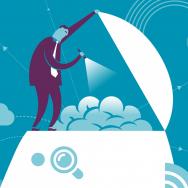In 25 years studying U.S. fundraising data, Prof. John List has noticed a gap between what the science says about giving habits and what the charitable market and nonprofits raising money are actually doing.
A leading economist at the University of Chicago, List aims to close that gap in his research, examining the underlying motivations of donors across income groups and sharing insights with nonprofits, most recently during the virtual On Board conference on nonprofit board service, hosted by Chicago Booth’s Rustandy Center for Social Sector Innovation.
Instead of looking at charitable donations the traditional way—by examining the S&P 500 and the stock market—List studies data from 1971 to today looking at total giving as a percent of U.S. income.
Through that lens, total individual giving to charities remains stuck at 1.8% to 2.8% of income, said List, the Kenneth C. Griffin Distinguished Service Professor in Economics.
So how can nonprofits, board members and others move away from fundraising that leans on gut instinct to developing strategies to increase donations amid (and long after) the COVID-19 pandemic?
“I have tried to provide scientific insights and tried to explore where we can use science to enhance both what we know and also to enhance the [donation] bucket,” List said.
Below are four insights from List’s fundraising research.
Bigger gift matches aren’t that effective
Fundraisers laud a good “match rate,” List said, a gift that “challenges” or encourages someone to give because a donor has committed to matching every dollar raised. But do matches actually raise more money? And does a 2:1 match (or more) work even better?
Not really, according to List’s research. In a field experiment with a U.S. nonprofit that works on social and political issues, List sent a letter to 50,000 households promoting one of four match rates: 1:1 match, 2:1, 3:1 and no match for the control group.
The experiment found that 19% more money was raised per letter in the matching treatments—but the effect mirrored the overall response rate, which was 22% higher in letters with matches.
So while matches did a great job of bringing in new donors, List said, no additional dollars were raised from the higher match rates. To avoid wasting matching gifts, he encouraged nonprofits to keep giving matches to 1:1.
‘One size fits all’ leaves money on the table
Research shows people are motivated to give for different reasons, List said, so “one size fits all” fundraising campaigns likely miss out on donations.
Most donors, especially small donors, are not buying a private good when they give. “They’re giving because they enjoy the warm, fuzzy feeling of helping or doing a good thing,” List said. Data shows that women especially give more due to altruism or social pressure, while men are more price sensitive.
And while men give more than women on average—$2,127.09 annually compared to $857.50—List said women out-give men across every level of income (except the ultra-wealthy) when you look at percent of total income.
Non-price incentives—like offering a mug or tote bag—can have strong effects on giving, he said. And the success of long-run campaigns can depend on these incentives to attract first-time donors.
List encouraged fundraisers to lean on insights from behavioral economics and machine learning and algorithms to do a better job targeting your average or “modal” donor.
How COVID-19 changed giving habits
The coronavirus has affected giving habits, with fewer people giving to charity since the start of the pandemic, according to recent data List has collected across the United States and Germany.
List also noted that the people who are giving are donating less, and they’re also giving to different types of causes than in the past—notably, charities tackling health-related issues.
People are also much more price sensitive than before the pandemic, something he’s seen while studying the same group before and after the pandemic started.
To help the philanthropic sector, List said the Biden administration could provide more tax incentives for donors and continue allowing an existing non-cash giving loophole that lets high-capacity donors to directly donate an asset (like Google stocks) to a charity to avoid paying the long-term capital gains tax.
Ultra-wealthy donors are similar to small donors—with exceptions
In a recent analysis of 2012 IRS data, researchers see how much power ultra-wealthy donors wield. Looking at donations across adjusted gross income, List said the top 1% of people gave close to 40% of total U.S. donations, and the top 0.01% accounted for 14% of total gifts.
List encouraged fundraisers to try some of the same tactics on high-capacity donors, since their giving habits aren’t that dissimilar from the modal donor, citing data from a field experiment he did in partnership with Chicago Booth before the pandemic.
Researchers sent solicitation letters with varying messages and prices to nearly 6,000 high-capacity Booth donors, each with a median annual giving of at least $25,000. Donors responded to letters emphasizing program quality, but different match rates had little impact and too many contacts could have a negative effect (aka donor fatigue).
Unlike small donors, who act quickly, high-capacity donors had a longer lag time between the ask and a donation. By leveraging List’s insights, researchers helped generate over $30 million in incremental donations for the university.
“Everything I’ve talked about today should be applied to make our donor pipeline bigger,” he said. “Thanks for trying to change the world for the better.”
—This story was first published by the Rustandy Center for Social Sector Innovation.

